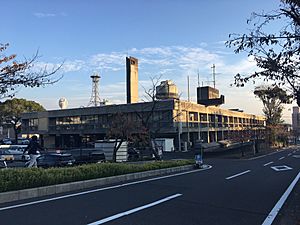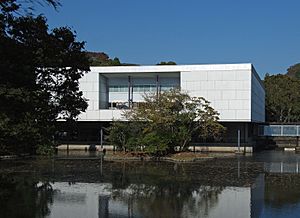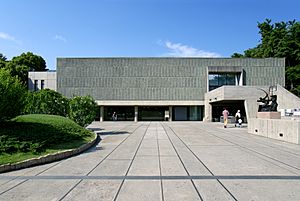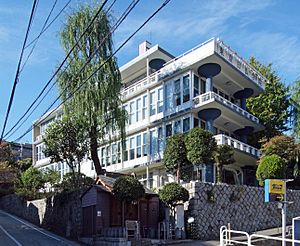Junzo Sakakura facts for kids
Quick facts for kids
Junzo Sakakura
|
|
|---|---|
| Born | 1901 Hashima, Gifu Prefecture
|
| Died | 1969 |
| Nationality | Japanese |
| Alma mater | Tokyo Imperial University |
| Occupation | Architect |
| Awards | Former president of the Architectural Association of Japan |
| Buildings | Kamakura Museum of Modern Art |
Junzo Sakakura (1901–1969) was a famous Japanese architect. He was also the president of the Architectural Association of Japan, a group for architects.
After finishing university, he went to Paris, France. There, he worked for a very famous architect named Le Corbusier. Junzo Sakakura became the head of Le Corbusier's studio during his seven years there.
When he returned to Japan, he started his own architecture company. He became a key part of the modern architecture movement in Japan. In 1959, he even worked with Le Corbusier again on the National Museum of Western Art in Tokyo.
Contents
Early Life and Learning About Architecture
Junzo Sakakura was born in Hashima-gun, Gifu Prefecture, Japan. In 1923, he started studying art history at Tokyo Imperial University. He finished his studies there in 1927.
Working with Le Corbusier
In 1930, Sakakura traveled to France to join Le Corbusier's studio. He left Japan at a good time, as the country was facing money problems and political trouble.
Le Corbusier asked Sakakura to first study architectural construction for six months. After that, he began his training in the studio. Every day, Le Corbusier would come to the studio. He would talk to the architects about their projects. He also sat with the students and drew his ideas.
As Sakakura became more trusted, he became a project architect. Then, he became the chief of the studio. Students would ask him for advice when Le Corbusier was not around.
Some projects in the office that might have influenced Sakakura later were the Villa Savoye and the Swiss pavilion.
Designing the Paris Exposition Pavilion
In 1936, a professor named Kishida Hideto was in charge of a competition. This competition was to design the Japanese Pavilion for the 1937 Paris Exposition. At first, another design was chosen. But the French government wanted the building to use French materials and workers.
This led to Sakakura getting the job, as he had just come back from Le Corbusier's office. Sakakura went back to France to watch over the project. Unexpected problems at the building site made him change the design. He asked Le Corbusier for advice on these changes.
The building had gray walls and stood on black piloti (columns). It had an open floor plan and ramps for access. This design was given the "Grand Prix" award at the Exposition.
Famous Buildings by Junzo Sakakura
The Museum of Modern Art, Kamakura (1951) Sakakura won a competition to design this museum. It is located on the grounds of the Tsurugaoka Hachiman-gū Shrine in Kamakura. The building has a white box on the second floor for art galleries. This box is held up by thin red and green steel columns. The ground floor, which faces a lake, is built with Oya Stone.
The International House of Japan, Tokyo (1955) Sakakura worked with his friends Kunio Maekawa and Junzō Yoshimura on this building. It is in Roppongi, Tokyo, and helps with cultural exchange. It is mostly made of concrete. The public areas of the building are covered with Oya Stone. This building won an important design award.
National Museum of Western Art, Tokyo (1959) This is the only building in Japan designed by Le Corbusier himself. Le Corbusier's three Japanese students, Kunio Maekawa, Junzo Sakakura, and Takamasa Yoshizaka, helped build it. They made sure the plans were followed and supervised the construction. Le Corbusier liked this way of working so much that he used it for other projects too.
West Plaza of Shinjuku Station, Tokyo (1967) This was one of his biggest city design projects. It is a two-story plaza that includes a bus station. Two large ramps in the middle allow taxis to go from the ground level down to the west exit of Shinjuku Station.
Junzo Sakakura's Legacy
A Japanese design magazine called Casa Brutus named Junzo Sakakura one of Japan's Modern Masters. The Kamakura Museum of Modern Art held a special show of Sakakura's work from May to September 2009.
Selected Projects
- 1937 Japanese Pavilion at the Paris Expo
- 1951 Kamakura Museum of Modern Art, Kamakura
- 1955 International House of Japan, Tokyo
- 1959 Hashima City Hall, Gifu
- 1959 Silk Centre, Yokohama
- 1962 Kure City Hall and Municipal Auditorium, Kure
- 1964 Hiraoka City Hall, Hiraoka
- 1966 West Plaza of Shinjuku Station and Underground Parking Lot, Tokyo
See also
 In Spanish: Junzō Sakakura para niños
In Spanish: Junzō Sakakura para niños






